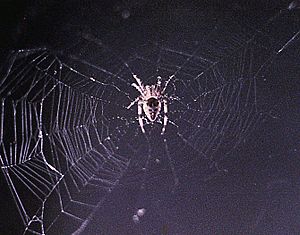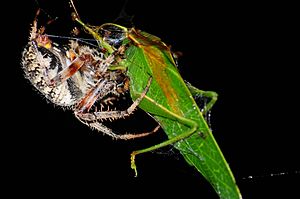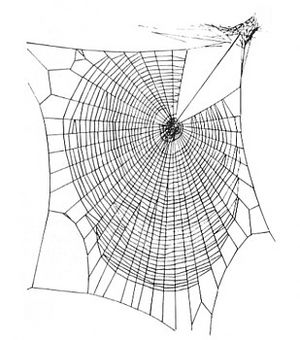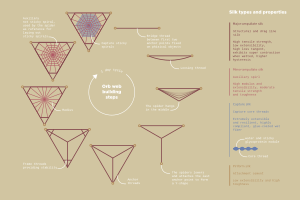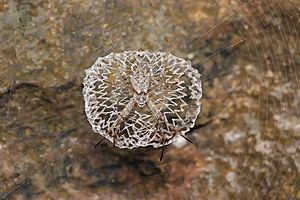Spider web facts for kids
A spider web is a sticky net that spiders make from silk. They use it to catch their prey, like insects. When insects fly or crawl into the web, they get stuck. Then the spider can eat them. Most spider webs are very thin, but they are also super strong! Different kinds of spiders make different types of webs. Spiders build different webs in different places to catch many kinds of food.
Contents
How Spiders Make Silk
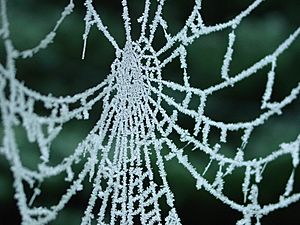
Spiders started making silk a very long time ago, when they moved from water to land. This was in the Early Devonian period. At first, they used silk to protect their bodies and their eggs. Over time, spiders began using silk for hunting. They started with guide lines and signal lines. Then they made ground or bush webs. Finally, they developed the amazing aerial webs we see today.
Spiders make silk from special parts called spinnerets. These are located at the end of their abdomen. Each spinneret has glands that produce different types of silk for different jobs. For example, one type of silk is a safety line they trail behind them. Another is sticky silk for trapping prey. There's also fine silk for wrapping up their food. Some spiders can make up to eight different kinds of silk in their lives!
Most spiders have three pairs of spinnerets, and each pair has its own job. Some spiders have only one pair, while others have as many as four.
Webs help spiders catch food without using a lot of energy to chase it. This makes catching food very efficient. However, building a web uses a lot of energy too. This is because silk is made of protein. Also, over time, the silk loses its stickiness. This means it won't catch prey as well. So, spiders often eat their own web every day. This helps them get back some of the energy they used to spin it. The silk proteins are then recycled.
Spider silk is incredibly strong. It's even stronger than the same weight of steel! It's also very stretchy. Scientists are studying its tiny structure. They hope to use this knowledge to create new materials for things like bullet-proof vests and artificial tendons. Researchers have even used special methods to produce the proteins needed for this amazing material.
Types of Webs
There are several types of spider webs found in nature. Many spiders are named after the kind of web they weave. Here are some different types of spider webs:
- Spiral orb webs: These are the classic round, wheel-shaped webs. They are made by spiders like orb-weavers.
- Tangle webs or cobwebs: These are messy, tangled webs often found in corners. They are made by spiders like Theridiidae.
- Funnel webs: These webs look like a funnel or tunnel. Some are made by primitive spiders, and others by modern ones.
- Tubular webs: These webs run up the bases of trees or along the ground.
- Sheet webs: These are flat sheets of silk.
Spiders use different types of silk to build their webs. Some silk is "sticky" to catch prey, and some is "fluffy." Webs can be built vertically (like most orb webs), horizontally (like sheet webs), or at any angle. Scientists think that these aerial webs developed as winged insects evolved. Since insects are a spider's main food, they likely played a big role in how spiders learned to hunt. Some sheet webs have loose, messy silk above them. These tangled "obstacle courses" confuse and knock down flying insects. This makes it easier for them to get caught in the web below. They can also help protect the spider from predators like birds and wasps.
Orb Web Construction
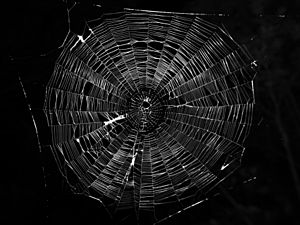
Most orb-weavers build their webs vertically, but some, like Uloborus diversus, build horizontal webs. When making an orb web, the spider uses its own body to measure distances.
Many webs stretch across gaps that the spider couldn't cross by crawling. To do this, the spider first releases a fine, sticky thread. This thread floats on a gentle breeze across the gap. When it sticks to something on the other side, the spider feels the change in vibrations. The spider then pulls in and tightens this first strand. After that, it carefully walks along it and makes it stronger with a second thread. This process is repeated until the thread is strong enough to hold the rest of the web.
After making the first thread strong, the spider creates a Y-shaped netting. These are the first three "spokes" or radials of the web. More radials are added, making sure the space between each one is small enough for the spider to cross. This means the number of radials depends on the spider's size and the web's size. A web is often about 20 times bigger than the spider that builds it!
Once the radials are done, the spider strengthens the center of the web with about five circular threads. It then makes a spiral of non-sticky, widely spaced threads. This allows the spider to move easily around its web while building it, working from the inside out. Next, starting from the outside and moving inward, the spider carefully replaces this spiral with a closer, sticky one. It uses the first radiating lines and the non-sticky spirals as guides. The spaces between each sticky spiral are exactly the distance from the tip of its back legs to its spinnerets. This is how the spider uses its own body as a measuring tool! As the sticky spirals are formed, the non-sticky ones are removed because they are no longer needed.
After the spider finishes its web, it chews off the first three center spiral threads. Then it waits. If the web gets broken without major damage during building, the spider usually doesn't try to fix it right away.
Once the web is spun, the spider waits on or near it for an animal to get trapped. The spider feels the impact and struggle of its prey through vibrations in the web. A spider sitting in the middle of its web is easy for birds and other predators to see. So, many orb-web spiders that hunt during the day hide at the edge of the web. They keep one foot on a "signal line" from the center. Or they might try to look like something that predators wouldn't want to eat.
Spiders usually don't get stuck in their own webs. This is because they can spin both sticky and non-sticky silk. They are careful to only travel on the non-sticky parts of the web. However, they are not completely immune to their own glue. Some web strands are sticky, and others are not. For example, if a spider waits on the outer edges of its web, it might spin a non-sticky signal line to the web's center to feel movement. But when they are spinning sticky strands, spiders have to touch them. They do this without sticking by moving carefully. They also have dense hairs and special non-stick coatings on their feet to prevent sticking.
How Spiders Use Webs
Some spiders don't use webs to catch prey directly. Instead, they jump out from hiding (like trapdoor spiders) or chase their prey down (like wolf spiders). The net-casting spider uses a mix of running and web spinning to hunt. This spider weaves a small net and holds it with its front legs. It then waits for prey. When an insect comes near, the spider lunges forward, wraps the victim in its net, bites it, and paralyzes it. This spider uses less energy to catch prey than a spider that just chases it. It also avoids the energy cost of building a large orb web.
Some spiders use a "signaling-snare" technique without spinning a full web. Several types of water-dwelling spiders rest their feet on the water's surface. This is similar to how an orb-web spider uses its web. When an insect falls onto the water and gets stuck by surface tension, the spider can feel the vibrations. It then runs out to catch its meal.
Uses by Humans
Spider web strands have been used for crosshairs or reticles in telescopes.
Today, scientists are working on ways to mass-produce spider silk. This has led to making prototypes for military protection, medical devices, and everyday consumer goods.
Images for kids
-
Spiral orb webs in Karijini, Western Australia
-
After severe, extensive flooding in Sindh, Pakistan, many trees were covered with spider webs.
See also
 In Spanish: Telaraña para niños
In Spanish: Telaraña para niños


